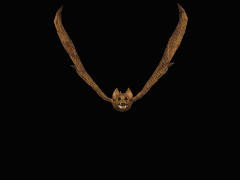


|
Opisthocomidae:
The Hoatzin (Opisthocomus hoazin), also known as the Hoactzin, Stinkbird, or Canje Pheasant, is an odd species of tropical bird found in the swamps of the Amazon and Orinoco rivers in South America. It is pheasant-sized — but much slimmer — long-tailed, long-necked and has a small head. It has an unfeathered blue face with red eyes, and its head is topped by spiky crest. It is a weak flier. There has been much debate about its relationships with other bird species. It has been given its own family, the Opisthocomidae, and has most frequently been suggested to possibly be related to gamebirds, turacos, or ground-dwelling New World cuckoos. Cladistic analysis of skeletal characters supports a relationship of the Hoatzin to the seriema family, and more distantly to the turaco and cuckoo families. However, both turacos and cuckoos have zygodactyl feet (two toes forward, two backward), whereas the Hoatzin has the more typical anisodactyl foot with three toes forward, one backwards. Sibley considered it likely to be a basal cuckoo based on DNA hybridization (Sibley and Ahlquist 1990). Avise et al (1994) echoed Sibley and Ahlquist's previous treatment, this time based on DNA sequence analysis. Subsequently, Hughes and Baker (1999) proclaimed the relationships of the Hoatzin "resolved" to be with turacos on the basis of their own larger DNA sequence analysis. However, in a much more comprehensive DNA sequence analysis Sorenson et al (2003) noted that all three previous DNA studies were flawed with erroneous data. They found clear evidence against the aforementioned putative relationships, and proposed instead a possible relationship between Hoatzin and doves. This seems to be closest to fact. The most comprehensive study of avian families to date holds that the Hoatzin and doves are among a newly discovered group, Metaves, that also purports to include many others of the most historically problematic families, e.g., flamingos, grebes, tropicbirds, sandgrouse, mesites, etc. (Fain and Houde 2004). While the hypothesis of their relationship is based on DNA, it is notable that these birds share some obscure anatomical features, e.g., the notarium - a fused series of thoracic vertebrae. Some, like Hoatzin, doves, and flamingos, also are unique in feeding their young esophageal secretions. This is a noisy species, with a variety of hoarse calls, one of which has been described as like a heavy smoker's wheezing. |
